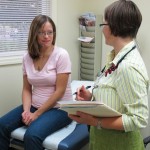What North Dakota Can Show Idaho About Training Rural Doctors

University of North Dakota School of Medicine and Health Sciences
Science Hall in 1903, home of the University of North Dakota's original medical school. Science Hall was razed in 1999.
With about 680,000 people, North Dakota has less than half as many residents as Idaho. Yet North Dakota has something that Idaho does not: its own medical school.
North Dakota’s school got its start in 1905 as a two-year program, where students would have to leave the state to finish their education. Since 1976, the University of North Dakota has had a full-fledged, four-year medical school to educate doctors in-state.
Many in North Dakota believe that having a medical school is one reason why the state does not have as severe a doctor shortage as other predominantly rural states. According to the 2011 Association of American Medical Colleges data book, North Dakota ranked 28th in the United States with 238 physicians per 100,000 people. Idaho ranks 49th, with 184 physicians per 100,000 people.
State Sen. Judy Lee, a Republican from Fargo, says the medical school is important to recruiting and retaining doctors in North Dakota. “There are some people who look at the cost per student graduated and say ‘boy that’s a lot of money’,” Lee says. “But it also costs a lot of money to have people not stay in the state.”
During North Dakota’s most recent two-year budget cycle, it cost $162 million to operate the school. Almost 30 percent of that, $47.8 million, comes directly from the state’s general fund. The rest is paid for by student tuition and fees, research grants and contracts, local funds and a percentage of property taxes.
While Idaho doesn’t have its own medical school, the state does subsidize tuition for 28 students per year to go to medical schools at the University of Washington in Seattle and the University of Utah in Salt Lake City. For these students, Idaho pays the difference between in-state and out-of-state tuition. Those programs, plus residency programs for family medicine and psychiatry, will cost Idaho a little more than $7 million during this fiscal year.
[spreadsheet key=”0AiLU6Cs5LWZIdFlmVUVhSDhoS2ZlTDBZSVc5Uk5qWGc” source=”U.S. Census Bureau | Association of American Medical Colleges” sheet=0 filter=0 paginate=0 sortable=1]
*Idaho also has a Veterans Administration residency, a psychiatry residency and an internal medicine residency, but those don’t include family medicine, and a third family medical residency program will be open by 2014 in Coeur d’Alene.
MacLeod says the state Legislature requires at least 80 percent of the med school’s students to be from North Dakota. North Dakota will graduate between 55 and 70 M.D.s over the next four years.
“Studies have found students that train in your state are more likely to stay there,” MacLeod says. “You don’t retain everyone, but particularly with residencies, you’ll be able to retain [many] of those students.”




